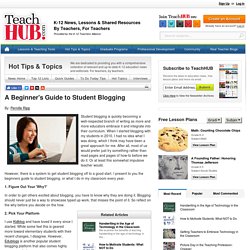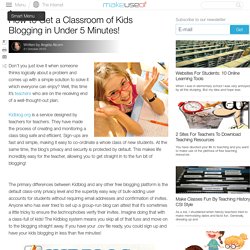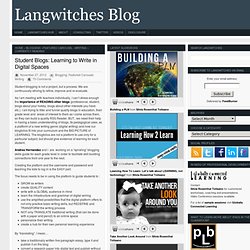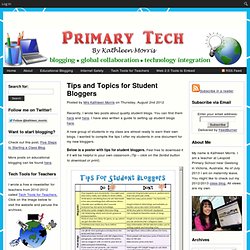

How to Add Gadgets/Widgets to Blogger. How to ensure impact with blogging! Blogging in the primary classroom. ASLA11 – Using blogging and edmodo in the classroom and library → This post has been designed to supplement my presentation for the Australian School Librarian Conference on Tuesday October 4.

Communicating for the 21st century: using tools such as Edmodo and student […] TeachMeet Sydney – from little things big things grow → I have been feeling guilty this year because I just haven’t made it to any TeachMeets yet. I held the first Sydney TeachMeet in my classroom back in 2010 and […] Kidblog - Simply Wonderful Classroom Tool. Kidblog, by Kidblog, gets kids writing, sharing, and experiencing technology in a whole new light… and it’s FREE.

Introduce students to the concept of blogging styles with different design themes, photo and video uploads, and linking capabilities. They will also learn the art of curating. A great way to give students a leg up and get familiar with the blogging platform and its multitude of options for future endeavors. Kidblog not only provides authentic learning but gives kids an authentic audience for students to share within the classroom and school. It also has the capabilities of reaching the global community. Kidblog is built by teachers, for teachers, so students can get the most out of the writing process. Developing Blogging Skills: Simple Rubric. Posted by Mrs Kathleen Morris on Wednesday, November 28th 2012 I’ve been toying with the idea of creating a blogging scope and sequence for a while.

However, something about that idea makes me uncomfortable. I don’t like the thought of limiting blogging skills to certain age levels. For example, a number of my grade two students were sourcing and attributing Creative Commons materials for blog posts, and using HTML in comments. 7 Reasons Your Students should be Blogging in 2013. One of the best things about blogging in the classroom is that it is a cross-curricular activity that can be used to teach any subject and develop just about any skills, from reading and writing to math, geography and everything in between.

A Beginner's Guide to Student Blogging. Student blogging is quickly becoming a well-respected branch of writing as more and more educators embrace it and integrate into their curriculum.

When I started blogging with my students in 2010, I had no idea what I was doing, which I think may have been a great approach for me. After all, most of us would prefer just try something rather than read pages and pages of how-to before we do it. Or at least this somewhat impulsive teacher would. Kick Start Your Blogging. Skip to content Personal Blogging This series guides you step by step through the process of setting up your own personal or professional educator blog.

Refer our class and student blogging series if you want to set up a class blog. Each step provides examples of personal educator blogs so you can check out how they are used by other educators. You can work through the activities in any order and at any time. Sign Up For Free Powered by WordPress | Hosted by Edublogs | Protected by CloudFlare AddThis Sharing Sidebar. How to Get a Classroom of Kids Blogging in Under 5 Minutes! Kidblog.org is a service designed by teachers for teachers.

They have made the process of creating and monitoring a class blog safe and efficient. Sign-ups are fast and simple, making it easy to co-ordinate a whole class of new students. At the same time, the blog’s privacy and security is protected by default. What Does Student Blogging Exactly Do? Muzy Offers a Neat Way to Blog With Pictures. Muzy is a neat blogging service that offers a neat way to blog with pictures and text.

Muzy offers more than two dozen apps for manipulating and displaying your pictures. If you don't have pictures that you want to share you can use the integrated image search to find images to write about and share. Beyond the picture apps Muzy offers text apps that you can use for writing short blog entries. Everything that you create becomes a part of your Muzy blog. Additionally, you can share all of your Muzy creations on Twitter and Facebook. When you first visit the Muzy website you'll see a pop-up box asking you to sign-in with a Facebook account. Applications for Education Muzy's integrated image search could be used by students to create a collage of images about a place, person, or event that they're studying. Muzy's T.O.S. requires users to be 13 or older.
Student Blogs: Learning to Write in Digital Spaces Student blogging is not a project, but a process.

We are continuously striving to refine, improve and re-evaluate. As I am meeting with teachers individually, I can’t stress enough the importance of READING other blogs (professional, student, blogs about your hobby, blogs about other interests you have etc.). I am trying to filter and funnel quality blogs in education, their grade level and areas of interest to them as I come across them, so they can build a quality RSS Reader. BUT.. we need their help in having a basic understanding of blogs, its pedagogical uses, as a platform of a new writing genre (digital writing) and how our blogfolios fit into your curriculum and the BIG PICTURE of LEARNING.
Blogmeister. Tips and Topics for Student Bloggers. Posted by Mrs Kathleen Morris on Thursday, August 2nd 2012 Recently, I wrote two posts about quality student blogs.

You can find them here and here. I have also written a guide to setting up student blogs here. A new group of students in my class are almost ready to earn their own blogs. I wanted to compile the tips I offer my students in one document for my new bloggers. Below is a poster with tips for student bloggers. Blog.scs.sk.ca/mrs_kleins/rubric digital presentation ela 8 greek mythology.pdf. Blogging With Students. Skip to content Blogging With Students This series guides you step by step through the process of class and student blogging. Each step includes links to class blogs being used by educators so you can check out how other educators use their blogs. Many of the examples are from primary grades but the same principles apply regardless of student age including adult learner. The activities can be completed at your own pace and in any order! This series consists of: Sign Up For Free Powered by WordPress | Hosted by Edublogs | Protected by CloudFlare AddThis Sharing.
Blogging Rubric. With a nod to the ever-brilliant-and-willing-to-share Kim Cofino, here is the rubric I’ve lately begun to use in my classroom for grading student blog posts. This is an experiment in action and depending on how this tool works, it is very likely that it will come under some revision. If anyone has any comments and suggestions, I would be happy to hear them. If you have posted a rubric of your own, please leave a link behind so that we can learn from each other. Here’s a link to the same file on google docs so you can copy it out and make any changes that fit your place.
A 60 Seconds Guide to The Use of Blogging in Education. EPortfolio Rubric (Digital Portfolio Rubric) University of Wisconsin-Stout — Schedule of Online Courses, Online Certificate Programs, and Graduate Degree Follow us on Facebook. University of Wisconsin - Stout — Schedule of Online Courses, Online Certificate Programs, and Graduate Degree Readings on Authentic Assessment. Blogger Dynamic Views. Blog4edu [licensed for non-commercial use only] / StudentBlogResources. Blogging in the Elementary Classroom. DogEared Book Blog - National Geographic Kids.
Blogger - creating your first blog. Add content to blogger. Blogging for Learning.